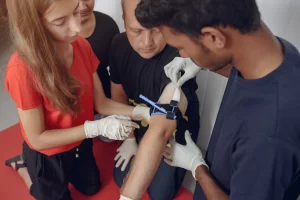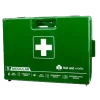
Recent Post
 Could You Recognise the Signs That Someone Needs a Defibrillator?
Could You Recognise the Signs That Someone Needs a Defibrillator?
September 12, 2023
Introduction
Every medical professional is a seasoned surgeon or a newly qualified paramedic. Understands the importance of having the right tools at their disposal. Among these crucial implements are trauma shears. An often-underappreciated staple in the landscape of medical emergencies. Trauma shears aren’t simply scissors, they are lifesaving tools. Designed for versatility, durability, and safety. Their unique design characteristics allow for quick and efficient cutting in high stakes. Time-sensitive situations where every second counts. Despite their unassuming appearance. These shears often play a pivotal role in patient outcomes during emergencies.
In this blog, we seek to shed light on the significance of trauma shears. Delving into their history, design, role in various emergency scenarios, and future developments. We aim to increase awareness about the instrumental part. These shears play in the realm of emergency care and beyond. And hope to give them the recognition they duly deserve.
History and Evolution of Trauma Shears
The birth and progression of trauma shears. The unsung heroes in medical emergencies are an intriguing tale. Laden with innovation, necessity, and a desire for enhanced patient care. As we delve deeper into this history. We discover how these instruments have become. An invaluable asset in emergency medical kits.
Origin and Initial Design
The inception of trauma shears dates back to the 1970s. Following the urgent need for a safe and effective tool. To cut through patients’ clothing without causing additional harm. Traditional scissors and knives posed considerable risks as they were sharp enough to cause unintended injuries.
The first trauma shears, or bandage scissors, were fashioned with a unique design to address this concern. They came with a blunt. Angled tip to ensure they wouldn’t pierce or harm the patient. While cutting through clothing. Also, their shape was particularly crafted to slide underneath bandages or clothes easily. Allowing for smooth and quick removal.
Evolution Over the Years
Over time, as the medical field advanced, so did the design of trauma shears. They evolved to be stronger and more durable, capable of cutting through, not just fabric. But also harder materials like seatbelts, leather, and even thin metal sheets. This evolution was crucial in expanding the utility of trauma shears, from simple bandage removal to versatile lifesaving tools in complex emergency scenarios.
The handles of trauma shears also saw design improvements. With better ergonomic features for comfortable use even during prolonged medical procedures. Many of today’s models include non-slip grips. Ensuring they can be handled securely even in high-stress, fast-paced situations.
Influential Individuals and Manufacturers
The development and popularisation of trauma shears would not be possible without the work of innovative manufacturers and medical professionals who recognised their potential. Brands like Leatherman and XSHEAR have made significant contributions. To improve trauma shear design and functionality over the years. They have been instrumental in creating highly durable, reliable, and user-friendly trauma shears. We see this in modern medical practice today.
Dr Sam Scheinberg is another significant figure in the history of trauma shears, as a surgeon in the Vietnam War. He was amongst the pioneers who recognised the necessity, for a safer cutting tool in emergency medicine. His input and experiences on the field played a crucial role in shaping the initial design of trauma shears.
The journey of trauma shears from its rudimentary initial design. To the sophisticated tools, we see today. Underscore their importance and indispensability in medical emergencies, through years of innovations and improvements. They have proven their mettle, underlining the fact that. Even the most humble tools can play a significant role in saving lives. And thus, the story of trauma shears continues, with more advancements to come. Ensuring they remain the unsung heroes of emergency care.
Unique Design Features of Trauma Shears
Material Construction and Durability
The efficacy of trauma shears primarily lies in their robust material construction. The blade of most high-quality trauma shears is made of stainless steel. Ensuring long-lasting durability and resistance to corrosion. This attribute is vital in medical emergencies. Where speed and precision can be the difference between life and death, some modern trauma shears even have titanium-coated blades. They are known for their remarkable sharpness and longevity.
Safety Features
Safety is at the forefront of trauma shear design. Resulting in unique features that separate them from traditional scissors. One of the most crucial safety elements is the blunt tip. Unlike standard scissors, trauma shears have a rounded edge. Reducing the risk of accidentally injuring a patient. When cutting away clothing or bandages.
The curved design is another defining safety feature of trauma shears. This curvature ensures that the lower surface is flat. Allowing them to slip easily under a patient’s clothing. Without causing discomfort or further injury. This curve also helps guide the shears smoothly. Enhancing the efficiency of their cutting action.
Different Sizes and Specific Applications
Trauma shears come in various sizes, each tailored for different scenarios. Smaller shears, often around 5.5 inches, are perfect for more delicate tasks. Such as paediatric care or intricate wound dressings. Larger trauma shears, typically around 7.5 inches. They are commonly used in emergency situations. To quickly cut through dense materials like leather, denim, or even thin metal.
Some trauma shears have additional features, such as serrated blades, for a better grip on the material being cut. Or handles with high-impact plastic for comfort and added durability. Certain designs even include a carabiner for easy attachment to a belt loop or medical bag.
In summary, the unique design of trauma shears. Characterised by their material durability and specific safety features. And varying sizes is what makes them indispensable tools in medical emergencies. These features ensure that trauma shears can perform under pressure. Prioritising patient safety and comfort during the rapid response required in crises.
The Role of Trauma Shears in Medical Emergencies
Trauma shears are often the unsung heroes of many medical emergencies. The go-to tool that facilitates the first line of action. In critical situations, time and safety are crucial factors. A patient’s clothes or seat belts. Often stand between healthcare professionals and the injury needing their attention.
Situation One – Car Accidents:
Trauma shears are vital in chaos. The aftermath of road accidents. They swiftly cut through seatbelts and clothing. Enabling paramedics to access and assess injuries rapidly.
Situation Two – Traumatic Injuries:
In the event of traumatic injuries. Such as gunshot wounds or severe lacerations. Trauma shears efficiently. Remove clothing around the affected area without inflicting further damage or discomfort.
Healthcare Professionals’ Experiences:
Weaving in narratives from doctors, nurses, and paramedics. We underscore the indispensable role trauma shears play in their everyday work.
Trauma Shears Beyond the Medical Field
Far from being restricted to the confines of hospitals and ambulances. Trauma shears prove their mettle in various other scenarios.
- Fire and Rescue Services: Trauma shears are effortlessly cut through. Fabric, plastic, and light metal. Making them an invaluable asset in extraction and rescue operations.
- Military and Outdoor Survival: Trauma shears have a firm place in survival kits. And military medical packs due to their versatility, robustness, and safety features.
- Everyday Applications: For the general public, trauma shears can serve multiple purposes. From gardening to DIY crafts, underscoring their versatility.
Purchasing and Maintaining Trauma Shears
Equipping yourself with a good pair of trauma shears is an investment. It’s important to consider quality, cost-effectiveness, and maintenance.
- Buying Trauma Shears: From assessing the quality of the blade to the comfort of the grip. We’ll guide you through what to look for when purchasing trauma shears.
- Maintaining Trauma Shears: Like any tool, trauma shears need the care to ensure longevity. We’ll share tips on how to clean and store your trauma shears properly.
- Lifespan: Depending on the usage and maintenance, a high-quality pair of trauma shears. Can last a considerable time, making them a worthy investment.
The Future of Trauma Shears
The evolution of trauma shears doesn’t stop here. As technology advances, so does the potential for this humble tool.
- Design and Material Advances: As materials science progresses. We might see trauma shears made from even more durable. And lightweight materials, enhancing their efficiency and lifespan.
- Changing Uses: With changing medical practices and procedures. The usage of trauma shears may adapt and evolve accordingly.
- Innovation and Technology: Could we see ‘smart’ trauma shears in the future? Equipped with sensors to guide rescuers? It’s an exciting thought.
Conclusion
From the hectic scene of an accident to the regulated calm of a hospital. Trauma shears continue to play a crucial role. Their versatility, reliability, and simplicity make them the unsung heroes of emergency medicine. Next time you see a pair of trauma shears, take a moment. To appreciate the innumerable crises they’ve helped resolve. And the countless lives they’ve helped save.
What Makes Trauma Shears Different from Regular Scissors?
Trauma shears have unique features that make them distinct from regular scissors. Their blunt tips minimise the risk of further injury. And they’re designed to cut through thick materials. Such as leather, denim, or even thin metal, like a seatbelt, quickly and easily.
Are Trauma Shears Only Used in Medical Settings?
While trauma shears are primarily used in medical emergencies, their uses extend far beyond this. Fire and rescue services, military operations, outdoor survival scenarios. And even everyday household applications can benefit from the utility of trauma shears.
How Should I Clean and Maintain My Trauma Shears?
Cleaning and maintaining trauma shears. Involve washing them with warm, soapy water and drying them thoroughly. For deeper cleaning, they can be disinfected with a mild bleach solution. Regular maintenance will ensure that the shears remain sharp and rust-free.
How Long Can I Expect My Trauma Shears to Last?
The longevity of trauma shears can vary based on frequency and type of use, as well as maintenance. However, a high-quality pair of trauma shears can last several years with proper care.
Are Expensive Trauma Shears Always Better?
While the quality often correlates with the price. It’s not always the case that the most expensive trauma shears are the best. Consider factors such as the quality of the blade, and the comfort of the grip. And the reputation of the brand when making your purchase.
Will We See Technological Innovations in Trauma Shears in the Future?
It’s highly likely. As technology advances, it’s possible that we’ll see ‘smart’ trauma shears in the future. Equipped with sensors or other technological enhancements. To assist in medical emergencies and other applications.






